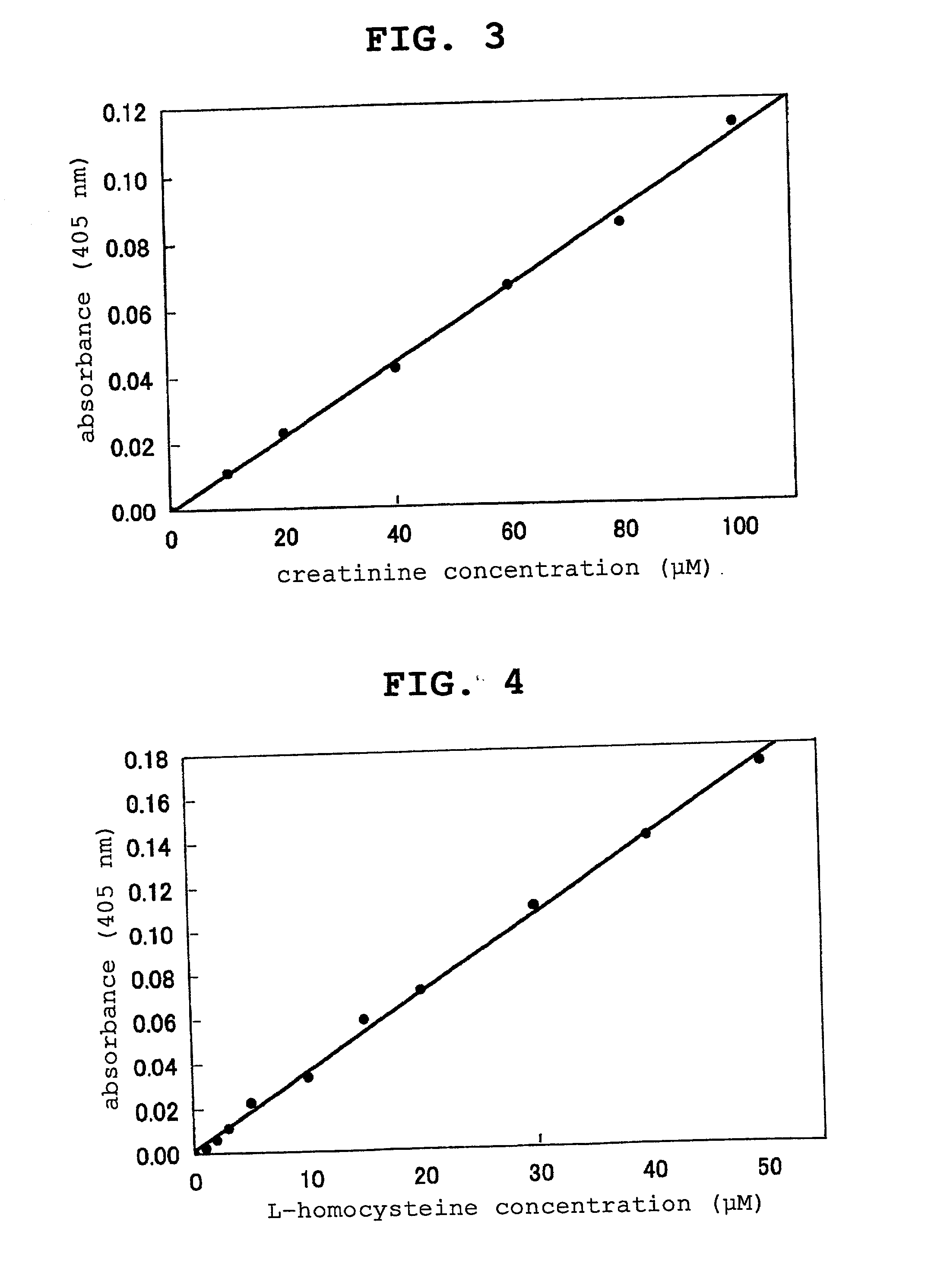Determination method of biological component and reagent kit used therefor
a biological component and reagent technology, applied in the direction of biochemistry apparatus and processes, microorganisms, oxidoreductases, etc., can solve the problems of long determination time, complicated manipulation, and insufficient determination sensitivity, and achieve the effect of reducing the number of steps, and improving the accuracy of the determination
- Summary
- Abstract
- Description
- Claims
- Application Information
AI Technical Summary
Benefits of technology
Problems solved by technology
Method used
Image
Examples
example 2
Preparation of Betaine-Homocysteine Methyltransferase
[0176] The activity of the betaine-homocysteine methyltransferase of the present invention was measured under the following reagent and measurement conditions.
[0177]
[0178] reagent A 50 mM potassium phosphate buffer (pH 7.5)
[0179] reagent B 100 mM DL-homocysteine solution (dissolved in reagent A)
[0180] reagent C 100 mM betaine (dissolved in reagent A)
[0181] reagent D 0.2% aqueous pentacyanoanmineiron(III) sodium solution
[0182] reagent E acetic acid
[0183] reagent F 10% aqueous sodium nitrite solution
[0184]
[0185] Reagent B (0.075 ml) and reagent C (0.125 ml) are added to an enzyme solution (2.3 ml) and admixed, which is followed by reaction at 37.degree. C. for 1 h. After the completion of the reaction, reagent D (5 ml) is added and the mixture is stirred. After standing for 1 min, 1 ml each of reagent E and reagent F were added in this order and the mixture is stirred. After standing for 30 min at room temperature, absorbance at 5...
example 3
Preparation of Dimethylglycine Oxidase
[0196] The activity of the dimethylglycine oxidase of the present invention was measured under the following reagent and measurement conditions.
[0197]
[0198] reagent A 100 mM dimethylglycine solution (dissolved in 100 mM potassium phosphate buffer (pH 7.5))
[0199] reagent B 0.1% aqueous 4-aminoantipyrine solution
[0200] reagent C 0.1% aqueous phenol solution
[0201] reagent D 25 U / ml aqueous peroxidase (TOYOBO; PEO-301) solution
[0202]
[0203] Reagent A, reagent B, reagent C and reagent D are mixed in ratios of 1.5 ml, 0.3 ml, 0.6 ml and 0.6 ml, respectively, to give a reagent mixture. This reagent mixture (3 ml) is preincubated at 37.degree. C. for about 5 min and 0.1 ml of enzyme solution is admixed, which is followed by reaction at 37.degree. C. for 4 min. Then, changes in absorbance at 500 nm per minute are measured. As a blind trial, distilled water is added to the reagent mixture instead of the enzyme solution and changes in absorbance are measu...
example 4
Measurement of Formaldehyde Standard Solution (1)
[0211] The activity of S-formylglutathione hydrolase to be used in this Example was measured according to the method described in Biochimica. et Biophysica Acta, 614, 81-91 (1980), and the enzyme activity of formate dehydrogenase was measured according to the method described in Eur. J. Biochem., 62(1), 151-160, Feb. 2, 1976.
[0212] The S-formylglutathione hydrolase to be used in this Example was obtained as follows.
[0213] One loopful of methylotrophic yeast (Candida boidinii) strain IFO1473 was inoculated to 60 ml YPD medium (1% D-glucose, 1% polypeptone, 1% yeast extract; pH 5.0), and after shaking culture at 30.degree. C. for 24 hr, the strain was transferred to 6 L of S-formylglutathione hydrolase producing medium (2% methanol, 0.5% D-glucose, 1% polypeptone, 1.6%yeast extract, 0.2% hydrogendipotassium phosphate, 0.7% dihydrogenpotassium phosphate) and subjected to aeration-agitation culture at 30.degree. C. for 48 hr. After comple...
PUM
| Property | Measurement | Unit |
|---|---|---|
| Fraction | aaaaa | aaaaa |
| Fraction | aaaaa | aaaaa |
| Fraction | aaaaa | aaaaa |
Abstract
Description
Claims
Application Information
 Login to View More
Login to View More - R&D
- Intellectual Property
- Life Sciences
- Materials
- Tech Scout
- Unparalleled Data Quality
- Higher Quality Content
- 60% Fewer Hallucinations
Browse by: Latest US Patents, China's latest patents, Technical Efficacy Thesaurus, Application Domain, Technology Topic, Popular Technical Reports.
© 2025 PatSnap. All rights reserved.Legal|Privacy policy|Modern Slavery Act Transparency Statement|Sitemap|About US| Contact US: help@patsnap.com



